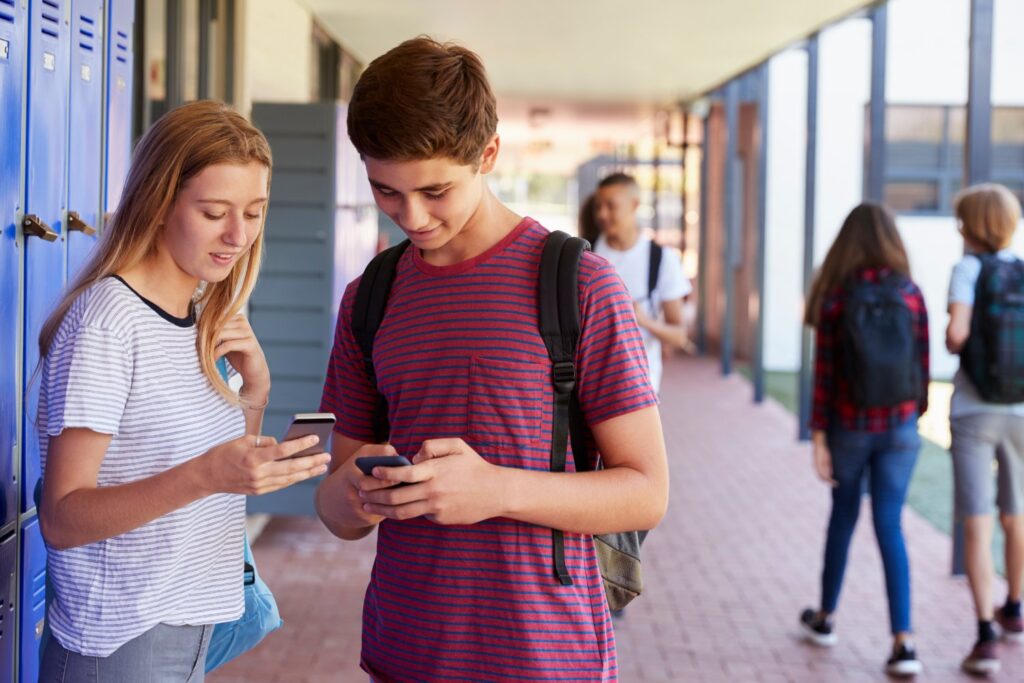This article will explore why students should have phones in school and the advantages of integrating mobile technology into the classroom.
In today’s digital age, smartphones have become integral to our daily lives. They have revolutionized how we communicate, access information, and carry out various tasks.
However, when it comes to schools, there is still a widespread belief that phones should be banned and students should focus solely on their studies.
Yet, recent studies and research have shown that allowing students to have phones in schools can have numerous benefits, ranging from increased safety and security to improved learning outcomes.

Balancing The Scales
Balancing the potential benefits of allowing students to use phones in the classroom with concerns can be tricky for schools. However, there are several strategies that schools can consider to find a balance between the two.
One of the most important strategies is to establish clear rules and guidelines on the appropriate use of phones. Schools can set rules such as no texting or browsing during class time. Or only allowing the use of phones for educational purposes.
These guidelines ensure that students use their phones responsibly and not causing distractions during class.
Another effective strategy is to educate students on responsible phone use and the potential consequences of misuse. This could include teaching them about the dangers of cyberbullying or the importance of respecting others’ privacy.
Schools should provide students with the knowledge and skills they need to use their phones responsibly. They can help minimize distractions and ensure that phones are used for their intended purpose.
Teachers can also use classroom management tools such as phone holders or designated phone-free zones to help minimize distractions.
This can help create a focused learning environment that encourages students to engage with the class material and participate in discussions.
Teachers can encourage active engagement in classroom activities and discussions to further reduce distractions.
By keeping students focused on learning and less likely to be distracted by their phones, teachers can help create a more effective and productive learning environment.
Additionally, schools can utilize technology to monitor phone use and ensure students use their phones appropriately. This could include tools that allow teachers to track which apps or websites students access on their phones during class time. Technology can help schools identify potential distractions or misuse and take steps to address them promptly.
Finally, schools can seek feedback from students on their experiences with using phones in the classroom and adjust their policies and guidelines accordingly. Feedback can help schools understand what is working well and what can be improved.
Potential Drawbacks
Allowing students to have phones in school can have potential drawbacks or negative consequences. This can include distraction, cyberbullying, academic cheating, disruption of class, and privacy concerns.
Schools can establish clear rules and guidelines to mitigate these issues and educate students on responsible phone use. Plus, how to use classroom management tools, encourage active engagement in class, and utilize technology to monitor phone use.
By implementing these strategies, schools can help minimize the negative consequences of allowing phones in school and create a more productive and effective learning environment for students.
Schools must carefully consider the potential drawbacks and address them to ensure that phones are used responsibly and for their intended purpose.
There are various other arguments that students should not have phones in school. If you want to know more, read my other article.
Educational Apps And Tools
Smartphones offer a wide range of educational apps and tools that can enhance student learning in various subjects. Some examples of educational apps include language learning, math and science, and flashcard apps. Plus, there are also productivity apps, and virtual field trips.
Language learning apps like Duolingo and Babbel provide students with interactive exercises, games, and quizzes. They help them learn and practice foreign languages.
Math and science apps like Photomath and Khan Academy provide step-by-step instructions. They also have practice problems for students to master math and science concepts.
Flashcard apps like Quizlet and Anki can create digital flashcards that students can use to review and memorize important information.
Productivity apps like Evernote and Google Drive can help students organize notes, documents, and assignments, making studying and staying on top of their workload easier.
Virtual field trips using apps like Google Expeditions and Nearpod VR can provide students with immersive virtual experiences of historical sites, museums, and other locations.
Educators can engage students in more interactive and personalized learning experiences by incorporating these educational apps and tools into their teaching.
Smartphones can also provide access to digital resources that can enhance student learning, such as e-books, online encyclopedias, and research databases.
Security And Safety
Smartphones can be valuable tools for improving school safety and security during emergencies or crisis situations. There are several ways in which smartphones can be used for this purpose.
Schools can use smartphone apps or text messaging systems to quickly alert students, staff, and parents of emergency situations, such as school closures, lockdowns, or weather emergencies. This allows for quick and effective communication during times of crisis.
In an emergency or crisis, school administrators can use mass communication tools, such as group chat or video conferencing, to communicate with students, staff, and first responders. This can help to coordinate response efforts and provide real-time updates.
Furthermore, smartphones can be used to track the location of students and staff during an emergency, allowing for a quick and targeted response. This can be particularly useful in situations where students or staff may be in danger, such as during an active shooter.
Schools can also use smartphone cameras as a tool for surveillance, allowing administrators and law enforcement to monitor for potential threats or suspicious activity. This can help to identify and respond to potential safety concerns before they escalate.
Finally, some schools have implemented smartphone panic button apps, allowing teachers and staff to quickly and discreetly summon help during an emergency.
Smartphones can be valuable tools for improving school safety and security. Nonetheless, schools need to balance the benefits of these tools with concerns about privacy and surveillance.
Schools should implement appropriate policies and guidelines for using smartphone-based safety and security tools. Then ensure that students, staff, and parents are aware of these policies.
Final Thoughts
In conclusion, the benefits of allowing students to have phones in school are evident. Smartphones can enhance student learning, improve school safety and security, and promote social and emotional well-being.
While there are certainly concerns and potential drawbacks associated with phone use in the classroom, schools can mitigate these risks by implementing appropriate policies and guidelines.
Overall, students should have phones in school. They have the potential to enhance academic success and improve student engagement. Plus, they prepare students for the digital world in which they will be living and working.



